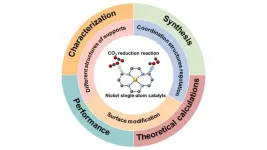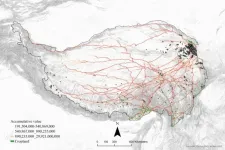(Press-News.org)
Electrocatalytic reduction of carbon dioxide (CO2) is considered as an effective strategy for mitigating the energy crisis and the greenhouse effect. Among the multiple reduction products, CO is regarded as having the highest market value as it is a crucial feedstock for Fischer-Tropsch process which can synthesize high-value long-chain hydrocarbons. Since the carbon dioxide reduction reaction (CO2RR) has complex intermediates and multiple proton-coupled electron transfer processes, improving the reaction activity and products selectivity remain two great challenges.
Single-atom catalysts (SACs) have the advantages of high atom utilization, tunable coordination structure and excellent catalytic performance. In addition, due to the special electronic structure of nickel metal, it is more likely to lose electrons to form empty outermost d-orbitals and exhibit high activity and selectivity for CO2RR to generate CO. A team of scientists summarized the considerable progress of Ni SACs in recent years. Their work is published in Industrial Chemistry & Materials on Jan. 09, 2024.
“Designing novel catalysts to improve the activity and selectivity of CO2RR is crucial for conquering the problem of energy crisis and environmental pollution,” said Yuhang Li, a Professor at East China University of Science and Technology, China, “In this minireview, we introduced three strategies used to improve the catalytic performance of Ni SACs, including different structures of supports, coordination structure regulation, and surface modification. In the end, we also summarized the existing challenges of Ni SACs and provided an outlook on future development to this field.”
SACs downsize the active sites to atomic scale and therefore get extraordinary electronic structure, powerful metal-support interactions, low-coordinated metal atoms, and maximum atom utilization at the same time. Hence, the application of SACs in CO2RR could effectively control the distribution of products and alleviate the cost of products separation.
“Some research based on crystal-field theory has indicated that the d-orbital electronic configurations of central metals are significant to the selectivity and activity of CO2RR,” Li said, “In the case of nickel as the central metal atom, it is more likely to form the vacant outermost d-orbital to facilitate the electron transfer between the C atom of CO2 and the Ni atom. Therefore, the absorbed CO2 molecules can be efficiently activated. Ni SACs can also minimize the reaction potential of CO2-CO conversion, which is of great importance to enhance the selectivity towards CO.”
“Ni SACs have achieved continuous progress in recent years. From a microscopic point of view, the design strategies include choosing different substrates, regulating the coordination structure and modifying the catalyst surface. The electronic structure of the active center is the most crucial factor affecting catalytic performance,” Li said.
There is still tremendous potential for Ni SACs in future designs and applications. Precise modulation of the microstructure provides more active sites and therefore further enhances the performance of Ni SACs. Optimization of the electrolytic cells and development of more types of electrolytes can expand the range of Ni SACs applications and enable large-scale commercialization in the future. In addition, researchers think that developing more in-situ techniques to gain deeper insights into the relationship between material structure and properties can provide valuable guidance for designing higher-value Ni SACs.
“In this minireview, our main goal is to provide readers with the current research progress in Ni SACs in CO2RR and to show our insights into the design and application of single-atom catalysts.,” Li said.
The research team includes Ziyan Yang, Rongzhen Chen, Ling Zhang, Yuhang Li, and Chunzhong Li from East China University of Science and Technology.
This research is funded by the National Natural Science Foundation of China, Shanghai Municipal Science and Technology Major Project, the Shanghai Scientific and Technological Innovation Project, “the Fundamental Research Funds for the Central Universities”, and Shanghai Rising-Star Program.
Industrial Chemistry & Materials is a peer-reviewed interdisciplinary academic journal published by Royal Society of Chemistry (RSC) with APCs currently waived. Icm publishes significant innovative research and major technological breakthroughs in all aspects of industrial chemistry and materials, especially the important innovation of the low-carbon chemical industry, energy, and functional materials.
END
In a study published today in Marine Policy, researchers have unveiled striking evidence that fisheries management decisions such as spatial fisheries restrictions can increase greenhouse gas emissions. The study, conducted by a team of scientists led by postdoctoral researcher Kim Scherrer at the University of Bergen, sheds light on the unforeseen consequences of policy changes on fishing fleets and their carbon footprint.
In the North Atlantic, international agreements often allow fleets to follow the fish across national borders. This allows fishers to catch the fish where it is most efficient. But when the UK left the EU (Brexit), ...
University of Sydney researchers have shown it is possible to shield plants from the hungry maws of herbivorous mammals by fooling them with the smell of a variety they typically avoid.
Findings from the study published in Nature Ecology & Evolution show tree seedlings planted next to the decoy smell solution were 20 times less likely to be eaten by animals.
“This is equivalent to the seedlings being surrounded by actual plants that are unpalatable to the herbivore. In most cases it does trick the animals into leaving the plants alone,” said PhD student Patrick ...
Do climate change deniers bend the facts to avoid having to modify their environmentally harmful behavior? Researchers from the University of Bonn and the Institute of Labor Economics (IZA) ran an online experiment involving 4,000 US adults, and found no evidence to support this idea. The authors of the study were themselves surprised by the results. Whether they are good or bad news for the fight against global heating remains to be seen. The study is being published in the journal Nature Climate Change. STRICTLY EMBARGOED: Do not publish before Friday, February 02, 11 a.m. CET!
A surprisingly large number of people ...
Scientists from the German Cancer Research Center (DKFZ) and Heidelberg University investigated in mice how spreading tumor cells behave at the site of metastasis: Some tumor cells immediately start to form metastases. Others leave the blood vessel and may then enter a long period of dormancy. What determines which path the cancer cells take is their epigenetic status. This was also confirmed in experiments with human tumor cells. The results of the study could pave the way for novel diagnostic and therapeutic applications.
What makes cancer so dangerous? ...
The 1 million-square-mile Tibetan Plateau — often called the “roof of the world” — is the highest landmass in the world, averaging 14,000 feet in altitude. Despite the extreme environment, humans have been permanent inhabitants there since prehistoric times.
Farming and herding play major roles in the economy of the Tibetan Plateau today — as they have throughout history. To make the most of a difficult environment, farmers, agropastoralists and mobile herders interact and move in conjunction with one another, which in turn shapes ...
World Wetlands Day: Bogs hold an important key to the climate crisis
Peat bogs store twice as much CO2 as all of the world's forests combined. A new research center at the University of Copenhagen will map Earth’s wetlands and provide important knowledge about the greenhouse gas budgets of these areas. The Global Wetland Center will teach us how to contain carbon from plants and trees in bogs and other wetlands – and preserve it as well as the ancient bog bodies also found there.
He is world-renowned ...
Researchers at the University of Auckland are running a trial of castor oil as a potential safe and natural treatment for dry-eye disease following a successful pilot study.
While exact figures aren’t available for New Zealand, in Australia, it is estimated dry-eye disease affects around 58 percent of the population aged over 50.
Advancing age, menopause, increased screen time, contact lens wear are just some of the risk factors for developing dry eye disease.
Blepharitis is the most common cause of dry-eye disease, accounting for more than 80 percent of cases. It is a chronic condition with no known cure.
“Currently, patients ...
In a study recently published in the PNAS on Jan. 30, a research team led by Prof. CAO Xiaofeng from the Institute of Genetics and Developmental Biology of the Chinese Academy of Sciences, in collaboration with researchers from the Southern University of Science and Technology, reported a new understanding of how light affects plant growth.
Light plays a central role in plant growth and development, providing an energy source and governing various aspects of plant morphology. Post-transcriptional splicing (PTS) has been previously discovered to generate polyadenylated full-length transcripts. These transcripts, ...
A group of patients with a hereditary disorder have had their lives transformed by a single treatment of a breakthrough gene-editing therapy, according to the lead researcher.
The patients from New Zealand, the Netherlands and the UK have hereditary angioedema, a genetic disorder characterised by severe, painful and unpredictable swelling attacks. These interfere with daily life and can affect airways and prove fatal.
Now researchers from the University of Auckland, Amsterdam University Medical Center and Cambridge University Hospitals have successfully treated more than ten patients with the CRISPR/Cas9 therapy, ...
A molecule created at the University of Auckland is one step closer to becoming a treatment for an extremely rare and severely debilitating neurological disorder called Phelan-McDermid syndrome. Children with the disorder showed significant improvements in a phase two clinical trial in the US, Neuren Pharmaceuticals, which is listed on the Australian Securities Exchange, said in December.
Next steps would be a phase three trial and seeking approval from the US Food & Drug Administration. The molecule, NNZ-2591, comes from work years ago ...




